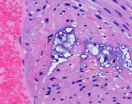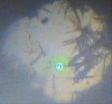(Press-News.org) SAN ANTONIO (Sept. 25, 2014) — The long-observed association between pneumonia and heart failure now has more physical evidence, thanks to research in the School of Medicine at The University of Texas Health Science Center at San Antonio.
The researchers found proof that Streptococcus pneumoniae, the leading cause of community-acquired pneumonia, actually physically damages the heart. The bacterium leaves tiny lesions that researchers detected in mouse, rhesus macaque and human autopsy tissue samples.
"If you have had severe pneumonia, this finding suggests your heart might be permanently scarred," said study senior author Carlos Orihuela, Ph.D., associate professor of microbiology and immunology at the UT Health Science Center San Antonio.
It's not yet known whether the small lesions contribute to increased risk of death in humans or if the scarring that occurs afterward is permanent, ultimately diminishing cardiac function in individuals who have recovered from a severe infectious disease episode. The team will study the long-term ramifications in non-human primates at the Texas Biomedical Research Institute's Southwest National Primate Research Center.
Streptococcus pneumoniae in the blood invaded the heart and formed lesions in the myocardium, the muscular middle layer of the heart wall, the researchers showed. The team identified mechanisms by which the bacterium is able to spread across endothelial cells in cardiac blood vessels to travel to and infect the heart.
"Fortunately, we have a candidate vaccine that can protect against this," Dr. Orihuela said. The Health Science Center, St. Jude's Children's Research Hospital in Memphis, Tenn., and the University of Oklahoma have claimed intellectual property protection on the vaccine project. The candidate vaccine acts to stop both the movement of the infection into the heart and the toxin that kills heart muscle cells called cardiomyocytes. The vaccine protected immunized animals against cardiac lesion formation, the study showed.
Study limitations included the small sample size of human tissues analyzed, the researchers noted. The American Heart Association and the National Institutes of Health funded the project. The journal PLoS Pathogen published the study online Sept. 18.
INFORMATION:
Armand Brown, a Translational Science Training Scholar studying for his Ph.D. at the Health Science Center, is lead author. Other co-authors from the Health Science Center include Marcus Restrepo, M.D., of the Division of Pulmonary Diseases and Critical Care Medicine and the South Texas Veterans Health Care System; Martha Hanes, D.V.M., of the Department of Laboratory Animal Resources; and Claude Jourdan Le Saux, Ph.D., of the Janey and Dolph Briscoe Division of Cardiology in the School of Medicine.
On the Web and social media
For current news from the UT Health Science Center San Antonio, please visit our news release website, like us on Facebook or follow us on Twitter.
About the UT Health Science Center at San Antonio
The University of Texas Health Science Center at San Antonio, one of the country's leading health sciences universities, ranks in the top 3 percent of all institutions worldwide receiving National Institutes of Health funding. The university's schools of medicine, nursing, dentistry, health professions and graduate biomedical sciences have produced more than 29,000 graduates. The $765 million operating budget supports eight campuses in San Antonio, Laredo, Harlingen and Edinburg. For more information on the many ways "We make lives better®," visit http://www.uthscsa.edu.
Pneumonia bacterium leaves tiny lesions in the heart, study finds
Three institutions collaborate to develop vaccine to treat infection
2014-09-25
ELSE PRESS RELEASES FROM THIS DATE:
New study shows that yoga and meditation may help train the brain
2014-09-25
New research by biomedical engineers at the University of Minnesota shows that people who practice yoga and meditation long term can learn to control a computer with their minds faster and better than people with little or no yoga or meditation experience. The research could have major implications for treatments of people who are paralyzed or have neurodegenerative diseases.
The research is published online in TECHNOLOGY, a new scientific journal featuring cutting-edge new technologies in emerging fields of science and engineering.
In the study, researchers involved ...
Researchers uncover structure of enzyme that makes plant cellulose
2014-09-25
WEST LAFAYETTE, Ind. - Purdue researchers have discovered the structure of the enzyme that makes cellulose, a finding that could lead to easier ways of breaking down plant materials to make biofuels and other products and materials.
The research also provides the most detailed glimpse to date of the complicated process by which cellulose - the foundation of the plant cell wall and the most abundant organic compound on the planet - is produced.
"Despite the abundance of cellulose, the nitty-gritty of how it is made is still a mystery," said Nicholas Carpita, professor ...
IU-Regenstrief CHICA system improves developmental delay screening and surveillance
2014-09-25
INDIANAPOLIS -- Is my child lagging behind physically, mentally or emotionally? Should I be concerned? When should I ask our pediatrician about it? What can I do to help my child?
A new study from Indiana University School of Medicine and Regenstrief Institute researchers reports that a computerized clinical decision support system is helping parents answer such questions. The system, which they developed to automate pediatric care guidelines, significantly increased the number of children screened for developmental delay at 9, 18 and 30 months of age, as recommended ...
Study identifies gauntlet of obstacles facing migrating pronghorn in greater Yellowstone
2014-09-25
One of North America's last remaining long-distance land migrations, better known as the Path of the Pronghorn, is being threatened by a mosaic of natural gas field development, highway traffic, and fencing in the upper Green River Basin, according to the Wildlife Conservation Society. WCS scientists used a model traditionally applied to identify resource related stopovers for migrating animals in order to identify impediments to migration of pronghorn.
The long-distance travels of the fleet-footed pronghorn through this part of the Greater Yellowstone Ecosystem was the ...
New research outlines promising therapies for small cell lung cancer
2014-09-25
CLEVELAND: Two recently published studies by a research team at University Hospitals (UH) Case Medical Center Seidman Cancer Center have the potential to advance treatments for small cell lung cell cancer (SCLC). This aggressive form of lung cancer has seen no treatment advances in 30 years and "is a disease in urgent need of new drug therapies," write the study's authors.
"In small cell lung cancer, which impacts about 30-40,000 people each year in the United States, there has been no therapeutic progress and very little research," says Afshin Dowlati, MD, lead author ...
Coping techniques help patients with COPD improve mentally, physically
2014-09-25
DURHAM, N.C. -- Coaching patients with chronic obstructive pulmonary disease to manage stress, practice relaxation and participate in light exercise can boost a patient's quality of life and can even improve physical symptoms, researchers at Duke Medicine report.
In a study published online Sept. 25, 2014, in the journal Psychosomatic Medicine, Duke researchers examined how telephone-based coaching could help patients with chronic obstructive pulmonary disease, or COPD, a progressive disease that limits airflow in the lungs.
About 15 million Americans have COPD, and ...
Solar cell compound probed under pressure
2014-09-25
Washington, D.C.— Gallium arsenide, GaAs, a semiconductor composed of gallium and arsenic is well known to have physical properties that promise practical applications. In the form of nanowires and nanoparticles, it has particular potential for use in the manufacture of solar cells and optoelectronics in many of the same applications that silicon is commonly used.
But the natural semiconducting ability of GaAs requires some tuning in order to make it more desirable for use in manufacturing these types of products. New work from a team led by Carnegie's Alexander Goncharov ...
A wriggly solution to a first-world problem
2014-09-25
Australian researchers have achieved groundbreaking results in a clinical trial using hookworms to reduce the symptoms of celiac disease.
The results are also good news for sufferers of other inflammatory conditions such as asthma and Crohn's disease.
In the small trial run over a year, 12 participants were each experimentally infected with 20 Necator americanus (hookworm) larvae.
They were then given gradually increasing doses of gluten – beginning with just one-tenth of a gram per day (the equivalent of less than a one-inch segment of spaghetti) and increasing in ...
Study finds global sea levels rose up to 5 meters per century at the end of the last 5 ice ages
2014-09-25
Land-ice decay at the end of the last five ice-ages caused global sea-levels to rise at rates of up to 5.5 metres per century, according to a new study.
An international team of researchers developed a 500,000-year record of sea-level variability, to provide the first account of how quickly sea-level changed during the last five ice-age cycles.
The results, published in the latest issue of Nature Communications, also found that more than 100 smaller events of sea-level rise took place in between the five major events.
Dr Katharine Grant, from the Australian National ...
Cryptogenic strokes may find explanation in the heart
2014-09-25
More than half of the patients who have suffered a stroke with no well-defined aetiology have an enlarged left atrial appendage of the heart, according to a Finnish study. The results indicate that the enlargement of the left atrial appendage may be an independent risk factor of strokes with cardiac origin.
Mr Mikko Taina, Licentiate of Medicine, presented the results in his doctoral thesis at the University of Eastern Finland.
Stroke is the leading cause of long-term disability and a major burden on health-care resources worldwide. Stroke is responsible for 10 per ...
LAST 30 PRESS RELEASES:
Numbers in our sights affect how we perceive space
SIMJ announces global collaborative book project in commemoration of its 75th anniversary
Air pollution exposure and birth weight
Obstructive sleep apnea risk and mental health conditions among older adults
How talking slows eye movements behind the wheel
The Ceramic Society of Japan’s Oxoate Ceramics Research Association launches new international book project
Heart-brain connection: international study reveals the role of the vagus nerve in keeping the heart young
Researchers identify Rb1 as a predictive biomarker for a new therapeutic strategy in some breast cancers
Survey reveals ethical gaps slowing AI adoption in pediatric surgery
Stimulant ADHD medications work differently than thought
AI overestimates how smart people are, according to HSE economists
HSE researchers create genome-wide map of quadruplexes
Scientists boost cell "powerhouses" to burn more calories
Automatic label checking: The missing step in making reliable medical AI
Low daily alcohol intake linked to 50% heightened mouth cancer risk in India
American Meteorological Society announces Rick Spinrad as 2026 President-Elect
Biomass-based carbon capture spotlighted in newly released global climate webinar recording
Illuminating invisible nano pollutants: advanced bioimaging tracks the full journey of emerging nanoscale contaminants in living systems
How does age affect recovery from spinal cord injury?
Novel AI tool offers prognosis for patients with head and neck cancer
Fathers’ microplastic exposure tied to their children’s metabolic problems
Research validates laboratory model for studying high-grade serous ovarian cancer
SIR 2026 delivers transformative breakthroughs in minimally invasive medicine to improve patient care
Stem Cell Reports most downloaded papers of 2025 highlight the breadth and impact of stem cell research
Oxford-led study estimates NHS spends around 3% of its primary and secondary care budget on the health impacts of heat and cold in England
A researcher’s long quest leads to a smart composite breakthrough
Urban wild bees act as “microbial sensors” of city health.
New study finds where you live affects recovery after a hip fracture
Forecasting the impact of fully automated vehicle adoption on US road traffic injuries
Alcohol-related hospitalizations from 2016 to 2022
[Press-News.org] Pneumonia bacterium leaves tiny lesions in the heart, study findsThree institutions collaborate to develop vaccine to treat infection



